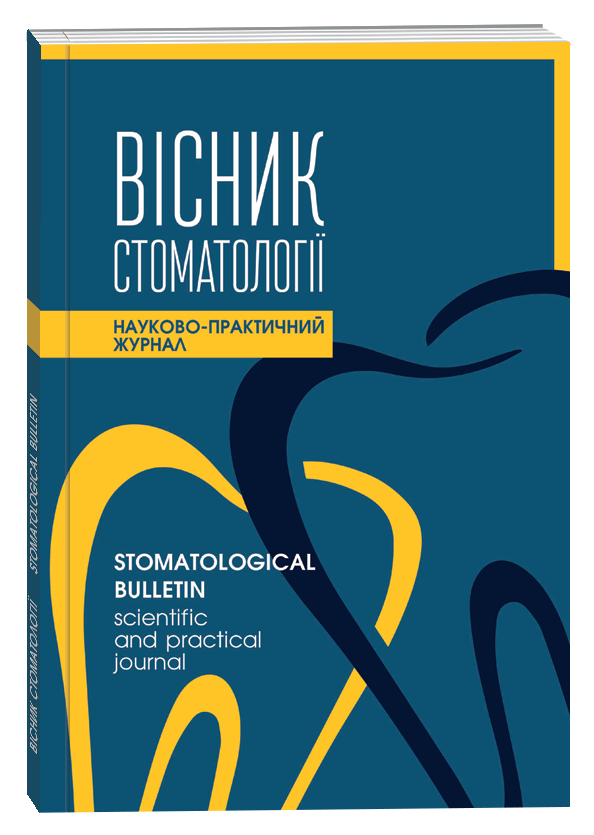FEATURES OF THE USE OF MICROIMPLANTS IN THE TREATMENT OF PATIENTS WITH ADENTIA
DOI:
https://doi.org/10.35220/2078-8916-2021-42-4.11Keywords:
microimplant, bracket system, atentiaAbstract
The aim of our work was to improve the method of orthodontic treatment of patients with adentia by using a self-made protracting spring and microimplant. Materials and methods of research. Based on the survey, examination of patients and the study of diagnostic models, a preliminary diagnosis was determined, which included the type of Main and concomitant deformities, the ratio of molars in the sagittal plane, adjacent dental pathology and the presence of somatic diseases. Materials and methods of research. To achieve this goal, we conducted a clinical examination according to the generally accepted method, according to the medical record of an orthodontic patient. Based on the survey, examination of patients and the study of diagnostic models, a preliminary diagnosis was determined, which included the type of Main and concomitant deformities, the ratio of molars in the sagittal plane, adjacent dental pathology and the presence of somatic diseases. The improved orthodontic method of treatment involves the use of a spring developed by US, acting on one side on a molar bracket, which is fixed to the crown of the tooth being moved according to generally accepted rules, and to an orthodontic self-tapping microimplant measuring 1.6 x 6 mm with a head and the presence of horizontal and vertical grooves. We analyzed the effectiveness of the proposed method of orthodontic treatment of patients with adentia in comparison with the generally accepted method. Computed tomography data from patients before treatment and after molar protrusion were examined and analyzed. Research results and their discussion. The fundamental difference between our proposed method of orthodontic treatment and the generally accepted straight arc technique is the ability to control the force and its moment applied to the tooth being moved. This ensures an even distribution of pressure on the root of the tooth. Our improved method of orthodontic treatment of patients with dental adentia ensures uniform, unidirectional, body movement of the tooth. The clinical manifestation of the body movement of teeth in the vestibulo-oral direction is the preservation of tooth angulation and its alignment after orthodontic treatment. Although both groups of adentia patients studied showed tooth angulation within the normal range, when using a retracting spring, a better degree of tooth alignment was observed, hence body displacement. Our proposed method makes it possible to form a moment of force that balances the vestibularly directed moment. Thus, the tooth is displaced without additional rotation.
References
Baik, Un-Bong, & Park, Jae (2012). Molar Protraction: Orthodontic Substitution of Missing Posterior Teeth. Smile with Orthodontic Clinic [in English].
Charles, J. (2015). Burstone, Kwangchul Choy The Biomechanical Foundation of Clinical Orthodontics. Quintessence Pub Co [in English].
Baik, U.B., Chun, Y.S., Jung, M.H., & Sugawara, J. (2012). Protraction of mandibular second and third molars into missing first molar spaces for a patient with an anterior open bite and anterior spacing. Am J Orthod Dentofacial Orthop. 141(6), 783-95. doi:10.1016/j.ajodo.2010.07.031 [in English].
Garrido, E., & Espínola, Gabriel (2016). Compensation due to lower first molar absence by means of traditional unilateral mesialization of the posterior segment. Revista Mexicana de Ortodoncia. 4,.e117-e122. 10.1016/j.rmo.2016.10.016 [in English].
Kravitz, N.D., & Jolley, T.V (2008). Mandibular molar protraction with temporary anchorage devices. Journal of clinical orthodontics. 6, 42, 351-5 [in English].
Wilmes, B., Vasudavan, S., & Drescher, D. (2019). Maxillary molar mesialization with the use of palatal miniimplants for direct anchorage in an adolescent patient. Am J Orthod Dentofacial Orthop. May;155(5):725-732. doi: 10.1016/j.ajodo.2019.01.011. PMID: 31053288 [in English].
Cousley Richard (2020). The Orthodontic Mini-Implant Clinical Handbook, Second Edition. DOI:10.1002/9781119509738 [in English].
Nakadzhima E. (2011). Bending of orthodontic wire. Practical guide. ABC [in English].
Tarawneh F., A. (2015). Papadopoulos, Moschos. Insertion and removal of orthodontic miniscrew implants.10.1016/B978-0-7234-3649-2.00014-2 [in English].
Urs,i W., Almedia, R., Tavano, O., & Henriques, J. (1990). Assessment of mesiodistal axial inclination through panoramic radiography. Journal of Clinical Orthodontics. 24. 166-173 [in English].
Dmitrijev M.O. (2016). Correlations of angular parameters of the upper jaw with the characteristics of the position of teeth and the profile of soft tissues of the face in residents of Ukraine of adolescent age.Reports of Morphology. 22 (2), 380-384 [in English].
Agrawal, P., Kapoor, D.N., Sharma, V.P. & Tandon, Pradeep. (2003). Assessment of mesiodistal angulations of teeth: A panoramic radiographic study. The Journal of Indian Orthodontic Society. 36. 96-102. 10.1177/0974909820030206 [in English].
Chang, H.-W., Huang, H.-L., Yu, J.-H., Hsu, J.-T., Li, Y.-F., & Wu, Y.-F. (2011). Effects of orthodontic tooth movement on alveolar bone density. Clinical Oral Investigations, 16(3), 679–688. doi:10.1007/s00784-011-0552-9 (https://doi.org/10.1007/s00784-011-0552-9) [in English].
Grjibovski, A.M. (2008). Confidence intervals for proportions. Human Ecology.14, 57-6 [in English].
Field A.P. (2005). Discovering statistics using SPSS. London, Sage Publications [in English].









